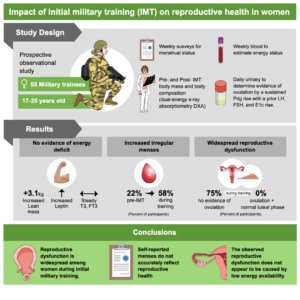Author: Kristin Popp, PhD
Military training imposes significant physical demands that uniquely impact female Warfighters, especially in terms of their reproductive health. Yet, there remains much to uncover about how these intense conditions affect hormone production and menstrual cycles among these women.
Our research at the U.S. Army Research Institute of Environmental Medicine (USARIEM) has tackled this question, offering new insights into the physiological effects of U.S. Army Basic Combat Training (BCT) on female Warfighters. This blog provides an overview of a recent study in this area, published in BJSM.
Why is This Study Important?
Our research addresses a significant gap in our understanding of female Warfighters’ health. Historically, reproductive health in military trainees has been assessed primarily through self-reported data, which doesn’t always reflect reproductive health or ovarian hormone profiles. Ovarian hormones play a crucial role in maintaining overall health and optimizing performance, as they regulate key physiological processes such as bone health, muscle function, and reproductive health.
In previously published work, about 50% of women report menstrual irregularities or disruptions during initial military training in the U.S. This new study, however, took a different approach by closely examining the hypothalamic-pituitary-ovarian (HPO) axis, a system that regulates reproductive function, including ovulation and the menstrual cycle. By doing so, our study provides a clearer picture of how military training impacts reproductive health.
How Did the Study Go About This?
We conducted a 10-week observational study to collect daily hormone measurements in 55 female trainees aged 22 to 23 years during Army Basic Combat Training (Fort Jackson, South Carolina – USA). By tracking daily hormone levels, including metabolites of estrogen and progesterone, our study aimed to get an accurate assessment of the HPO axis’s function throughout the training period. The study also assessed body composition before and after BCT by dual-energy X-ray absorptiometry and collected weekly blood samples to estimate energy availability and stress levels, respectively.
Our approach allowed us to uncover discrepancies between self-reported menstrual health and actual hormonal profiles, offering new insights into the physiological challenges female Warfighters face during U.S. Army training.
What Did the Study Find?
The results, published in the British Journal of Sports Medicine, were striking. Despite 42% of participants reporting regular menstrual cycles, none showed a healthy cycle according to hormonal data. The findings indicate that even those with seemingly normal cycles were experiencing reproductive dysfunction, including suppressed estrogen, which is crucial for bone health. Moreover, most participants lacked the progesterone surge indicative of ovulation, revealing widespread suppression of the HPO axis. These findings raise concerns about both short- and long-term health consequences.
Although low energy availability is a well-known cause of HPO axis suppression in female athletes, this study did not find evidence to support it as the cause in these female trainees. Instead, the HPO axis suppression experienced by these military trainees may be driven by other factors associated with the military training environment, such as elevated cortisol levels, lack of sleep, and the physical and psychological demands of BCT. These findings emphasize the need for further research to understand how long HPO axis suppression lasts without intervention, and to identify specific stressors that can be modified to improve hormone profiles and reduce ovarian suppression, with the ultimate goal of enhancing the health and performance of female Warfighters.
What Are the Key Take-Home Points?
- Reproductive Dysfunction is Prevalent: Our study found widespread suppression of the HPO axis among female trainees during Basic Combat Training, even in those who reported regular menstrual cycles. Self-reported data do not accurately reflect true reproductive health.
- Low Energy Availability was not Observed: We did not find evidence of low energy availability in our study. Other factors or a combination of factors such as increased cortisol and disturbed sleep may have contributed to the observed HPO axis suppression.
- Potential Health Risks: Long-term suppression of the HPO axis can lead to negative health outcomes, including infertility, weakened bones, and an increased risk of heart disease.
- The Need for Further Research: This study highlights the need for more research to understand the full extent of reproductive dysfunction in female Warfighters and how long this dysfunction lasts. This will allow the development of effective strategies for interventions to best support long-term injury prevention, and optimal health and performance of female Warfighters.

The opinions or assertions contained herein are the private views of the author(s) and are not to be construed as official or as reflecting the views of the Army, the Department of Defense, or the U.S. Government.
Author affiliations
- Military Performance Division, US Army Research Institute of Environmental Medicine, Natick, Massachusetts, USA
TRIA Orthopaedic Center, HealthPartners Institute, Bloomington, Minnesota, USA
Wu Tsai Female Athlete Program, Division of Sports Medicine, Boston Children’s Hospital, Boston, Massachusetts, USA